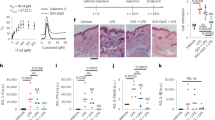Abstract
THE mechanism of action of numerous substances used as anti-inflammatory agents is not completely understood1,2. Recently it has been shown that potent blockers of protein synthesis such as actinomycin and puromycin are effective inhibitors of the inflammatory response3. In addition, it has been shown that hydrocortisone acetate might exert at least some of its anti-inflammatory action by interfering with a basic process of protein synthesis3,4. In the experiments reported here we tested the possible anti-inflammatory effect of compounds which are known to bind sulphydryl (SH) groups, because these groups are essential for the transfer reactions involved in the synthesis of proteins5–7. In addition, the anti-inflammatory activity of some commonly used drugs was tested in the presence of a compound carrying a sulphydryl group.
This is a preview of subscription content, access via your institution
Access options
Subscribe to this journal
Receive 51 print issues and online access
$199.00 per year
only $3.90 per issue
Buy this article
- Purchase on Springer Link
- Instant access to full article PDF
Prices may be subject to local taxes which are calculated during checkout
Similar content being viewed by others
References
Allison, F., in The Inflammatory Process, 559 (Academic Press, New York, 1965).
Shen, T. Y., in Topics in Medicinal Chemistry, 29 (John Wiley, New York, 1967).
Oronsky, A. L., and Nocenti, M. R., Proc. Soc. Exp. Biol. and Med., 125, 1297 (1967).
Oronsky, A. L., and Nocenti, M. R., Fed. Proc., 27, 476 (1968).
Hülsmann, W. C., and Lipman, F., Biochim. Biophys. Acta, 43, 123 (1960).
Sutter, R. P., and Moldave, K., J. Biol. Chem., 241, 1698 (1966).
Ibuki, F., and Moldave, K., J. Biol. Chem., 243, 44 (1968).
Meir, R., Schuler, W., and Desaulles, P., Experientia, 6, 469 (1950).
Villa-Trevino, S., Shull, K. H., and Farber, E., J. Biol. Chem., 238, 1757 (1963).
Shull, K. H., and McConomy, J., J. Biol. Chem., 241, 5060 (1966).
Duggan, D. E., and Noll, R. M., Arch. Biochem. Biophys., 109, 388 (1965).
Komorn, R., and Cafruny, E. J., J. Pharmacol., 148, 367 (1965).
Webb, J. L., in Enzyme and Metabolic Inhibitors, 3, 337 (Academic Press, New York, 1966).
Author information
Authors and Affiliations
Rights and permissions
About this article
Cite this article
ORONSKY, A., TRINER, L., STEINSLAND, O. et al. Effect of Sulphydryl Binding Compounds on the Inflammatory Process. Nature 223, 619–621 (1969). https://doi.org/10.1038/223619a0
Received:
Issue Date:
DOI: https://doi.org/10.1038/223619a0
This article is cited by
Comments
By submitting a comment you agree to abide by our Terms and Community Guidelines. If you find something abusive or that does not comply with our terms or guidelines please flag it as inappropriate.



